Hovercraft



Ahovercraft(pl.:hovercraft[1]), also known as anair-cushion vehicleorACV,[2]is anamphibious craftcapable of travelling over land, water, mud, ice, and various other surfaces.
Hovercraft use blowers to produce a large volume of air below thehull,or air cushion, that is slightly aboveatmospheric pressure.The pressure difference between the higher-pressure air below the hull and lower pressure ambient air above it produces lift, which causes the hull to float above the running surface. For stability reasons, the air is typically blown through slots or holes around the outside of a disk- or oval-shaped platform, giving most hovercraft a characteristic rounded-rectangle shape.
The first practical design for hovercraft was derived from a British invention in the 1950s. They are now used throughout the world as specialised transports in disaster relief, coastguard, military and survey applications, as well as for sport or passenger service. Very large versions have been used to transport hundreds of people and vehicles across theEnglish Channel,whilst others have military applications used to transport tanks, soldiers and large equipment in hostile environments and terrain. Decline in public demand meant that as of 2023[update],the only year-round public hovercraft service in the world still in operation serves between theIsle of WightandSouthseain the UK.[3][4]Oita Hovercraftis planning to resume services inOita, Japanin 2024.[5][6]
Although now a generic term for the type of craft, the nameHovercraftitself was atrademarkowned bySaunders-Roe(laterBritish Hovercraft Corporation(BHC), thenWestland), hence other manufacturers' use of alternative names to describe the vehicles.
History[edit]
Early efforts[edit]
There have been many attempts to understand the principles of high air pressure below hulls and wings. Hovercraft are unique in that they can lift themselves while still, differing fromground effect vehiclesandhydrofoilsthat require forward motion to create lift.
The first mention, in the historical record of the concepts behind surface-effect vehicles, to use the termhoveringwas by Swedish scientistEmanuel Swedenborgin 1716.[7]
The shipbuilderJohn Isaac Thornycroftpatented an early design for an air cushion ship / hovercraft in the 1870s, but suitable, powerful, engines were not available until the 20th century.[8]

In 1915, the AustrianDagobert Müller von Thomamühl(1880–1956) built the world's first "air cushion" boat (Luftkissengleitboot). Shaped like a section of a largeaerofoil(this creates a low-pressure area above the wing much like an aircraft), the craft was propelled by four aero engines driving two submerged marine propellers, with a fifth engine that blew air under the front of the craft to increase the air pressure under it. Only when in motion could the craft trap air under the front, increasing lift. The vessel also required a depth of water to operate and could not transition to land or other surfaces. Designed as a fasttorpedo boat,theVersuchsgleitboothad a top speed of over 32knots(59 km/h). It was thoroughly tested and even armed with torpedoes and machine guns for operation in theAdriatic.It never saw actual combat, however, and as the war progressed it was eventually scrapped due to a lack of interest and perceived need, and its engines returned to the air force.[9]
The theoretical grounds for motion over an air layer were constructed byKonstantin Eduardovich Tsiolkovskiiin 1926 and 1927.[10][11]
In 1929, Andrew Kucher ofFordbegan experimenting with theLevapadconcept, metal disks with pressurized air blown through a hole in the centre. Levapads do not offer stability on their own. Several must be used together to support a load above them. Lacking a skirt, the pads had to remain very close to the running surface. He initially imagined these being used in place ofcastersand wheels in factories and warehouses, where the concrete floors offered the smoothness required for operation. By the 1950s, Ford showed a number of toy models of cars using the system, but mainly proposed its use as a replacement for wheels on trains, with the Levapads running close to the surface of existing rails.[12]
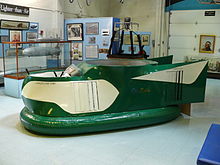
In 1931, Finnish aero engineer Toivo J. Kaario began designing a developed version of a vessel using an air cushion and built a prototypePintaliitäjä('Surface Glider'), in 1937.[13]His design included the modern features of a lift engine blowing air into a flexible envelope for lift. Kaario's efforts were followed closely in the Soviet Union by Vladimir Levkov, who returned to the solid-sided design of theVersuchsgleitboot.Levkov designed and built a number of similar craft during the 1930s, and his L-5 fast-attack boat reached 70 knots (130 km/h) in testing. However, the start ofWorld War IIput an end to his development work.[14][15]
During World War II, an American engineer,Charles Fletcher,invented a walled air cushion vehicle, theGlidemobile.Because the project was classified by the U.S. government, Fletcher could not file a patent.[16]
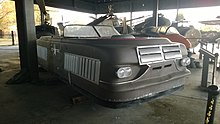
In April 1958,Fordengineers demonstrated the Glide-air, a one-metre (three-foot) model of a wheel-less vehicle that speeds on a thin film of air only 76.2 μm (3⁄1000of an inch) above its tabletop roadbed. An article inModern Mechanixquoted Andrew A. Kucher, Ford's vice president in charge of Engineering and Research noting "We look upon Glide-air as a new form of high-speed land transportation, probably in the field of rail surface travel, for fast trips of distances of up to about 1,600 kilometres (1,000 mi)".[12]
In 1959,Forddisplayed a hovercraftconcept car,theFord Levacar Mach I. [22] [23]
In August 1961,Popular Sciencereported on the Aeromobile 35B, an air-cushion vehicle (ACV) that was invented byWilliam R. Bertelsenand was envisioned to revolutionise the transportation system, with personal hoveringself-driving carsthat could speed up to 2,400 km/h (1,500 mph).
Christopher Cockerell[edit]

The idea of the modern hovercraft is most often associated withChristopher Cockerell,a British mechanical engineer. Cockerell's group was the first to develop the use of a ring of air for maintaining the cushion, the first to develop a successful skirt, and the first to demonstrate a practical vehicle in continued use. A memorial to Cockerell's first design stands in the village ofSomerleyton.
Cockerell came across the key concept in his design when studying the ring of airflow when high-pressure air was blown into the annular area between two concentrictin cans(one coffee and the other from cat food) and a hairdryer. This produced a ring of airflow, as expected, but he noticed an unexpected benefit as well; the sheet of fast-moving air presented a sort of physical barrier to the air on either side of it. This effect, which he called the "momentum curtain", could be used to trap high-pressure air in the area inside the curtain, producing a high-pressure plenum that earlier examples had to build up with considerably more airflow. In theory, only a small amount of active airflow would be needed to create lift and much less than a design that relied only on the momentum of the air to provide lift, like ahelicopter.In terms of power, a hovercraft would only need between one quarter to one half of the power required by a helicopter.
Cockerell built and tested several models of his hovercraft design in Somerleyton, Suffolk, during the early 1950s. The design featured an engine mounted to blow from the front of the craft into a space below it, combining both lift and propulsion. He demonstrated the model flying over manyWhitehallcarpets in front of various government experts and ministers, and the design was subsequently put on the secret list. In spite of tireless efforts to arrange funding, no branch of the military was interested, as he later joked, "The Navy said it was a plane not a boat; the RAF said it was a boat not a plane; and the Army were 'plain not interested'."[24]
SR.N1[edit]
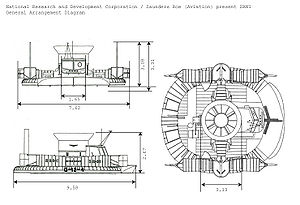
This lack of military interest meant that there was no reason to keep the concept secret, and it was declassified. Cockerell was finally able to convince theNational Research Development Corporationto fund development of a full-scale model. In 1958, the NRDC placed a contract withSaunders-Roefor the development of what would become theSR.N1,short for "Saunders-Roe, Nautical 1".
The SR.N1 was powered by a 450 hpAlvis Leonidesengine powering a vertical fan in the middle of the craft. In addition to providing the lift air, a portion of the airflow was bled off into two channels on either side of the craft, which could be directed to provide thrust. In normal operation this extra airflow was directed rearward for forward thrust and blew over two large vertical rudders that provided directional control. For low-speed manoeuvrability, the extra thrust could be directed fore or aft, differentially for rotation.
The SR.N1 made its first hover on 11 June 1959, and made its famed successful crossing of the English Channel on 25 July 1959. In December 1959, theDuke of Edinburghvisited Saunders-Roe atEast Cowesand persuaded the chief test-pilot, Commander Peter Lamb, to allow him to take over the SR.N1's controls. He flew the SR.N1 so fast that he was asked to slow down a little. On examination of the craft afterwards, it was found that she had been dished in the bow due to excessive speed, damage that was never allowed to be repaired, and was from then on affectionately referred to as the 'Royal Dent'.[25]
Skirts and other improvements[edit]


Testing quickly demonstrated that the idea of using a single engine to provide air for both the lift curtain and forward flight required too many trade-offs. ABlackburn Marboréturbojet for forward thrust and two large vertical rudders for directional control were added, producing the SR.N1 Mk II. A further upgrade with theArmstrong Siddeley Viperproduced the Mk III. Further modifications, especially the addition of pointed nose and stern areas, produced the Mk IV.
Although the SR.N1 was successful as a testbed, the design hovered too close to the surface to be practical; at 9 inches (23 cm) even small waves would hit the bow. The solution was offered byCecil Latimer-Needham,following a suggestion made by his business partner Arthur Ord-Hume. In 1958, he suggested the use of two rings of rubber to produce a double-walled extension of the vents in the lower fuselage. When air was blown into the space between the sheets it exited the bottom of the skirt in the same way it formerly exited the bottom of the fuselage, re-creating the same momentum curtain, but this time at some distance from the bottom of the craft.
Latimer-Needham and Cockerell devised a 4 feet (1.2 m) high skirt design, which was fitted to the SR.N1 to produce the Mk V,[26]displaying hugely improved performance, with the ability to climb over obstacles almost as high as the skirt. In October 1961, Latimer-Needham sold his skirt patents toWestland,who had recently taken over Saunders Roe's interest in the hovercraft.[27]Experiments with the skirt design demonstrated a problem; it was originally expected that pressure applied to the outside of the skirt would bend it inward, and the now-displaced airflow would cause it to pop back out. What actually happened is that the slight narrowing of the distance between the walls resulted in less airflow, which in turn led to more air loss under that section of the skirt. The fuselage above this area would drop due to the loss of lift at that point, and this led to further pressure on the skirt.
After considerable experimentation,Denys Blissat Hovercraft Development Ltd. found the solution to this problem. Instead of using two separate rubber sheets to form the skirt, a single sheet of rubber was bent into a U shape to provide both sides, with slots cut into the bottom of the U forming the annular vent. When deforming pressure was applied to the outside of this design, air pressure in the rest of the skirt forced the inner wall to move in as well, keeping the channel open. Although there was some deformation of the curtain, the airflow within the skirt was maintained and the lift remained relatively steady. Over time, this design evolved into individual extensions over the bottom of the slots in the skirt, known as "fingers".
Commercialisation[edit]

Through these improvements, the hovercraft became an effective transport system for high-speed service on water and land, leading to widespread developments for military vehicles, search and rescue, and commercial operations. By 1962, many UK aviation and shipbuilding firms were working on hovercraft designs, including Saunders Roe/Westland,Vickers-Armstrong,William Denny,Britten-NormanandFolland.[28]Small-scale ferry service started as early as 1962 with the launch of the Vickers-Armstrong VA-3. With the introduction of the 254 passenger and 30 car carryingSR.N4cross-channel ferry byHoverlloydandSeaspeedin 1968, hovercraft had developed into useful commercial craft.
Another major pioneering effort of the early hovercraft era was carried out byJean Bertin's firm in France. Bertin was an advocate of the "multi-skirt" approach, which used a number of smaller cylindrical skirts instead of one large one in order to avoid the problems noted above. During the early 1960s he developed a series of prototype designs, which he called "terraplanes" if they were aimed for land use, and "naviplanes" for water. The best known of these designs was theN500 Naviplane,built for Seaspeed by theSociété d'Etude et de Développement des Aéroglisseurs Marins(SEDAM). The N500 could carry 400 passengers, 55 cars and five buses. It set a speed record between Boulogne and Dover of 74 kn (137 km/h). It was rejected by its operators, who claimed that it was unreliable.[29]
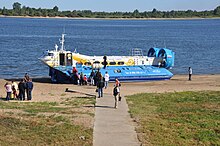
Another discovery was that the total amount of air needed to lift the craft was a function of the roughness of the surface over which it travelled. On flat surfaces, like pavement, the required air pressure was so low that hovercraft were able to compete in energy terms with conventional systems like steel wheels. However, the hovercraft lift system acted as both a lift and a very effective suspension, and thus it naturally lent itself to high-speed use where conventional suspension systems were considered too complex. This led to a variety of "hovertrain"proposals during the 1960s, including England'sTracked Hovercraftand France'sAérotrain.In the U.S.,Rohr Inc.andGarrettboth took out licences to develop local versions of theAérotrain.These designs competed withmaglevsystems in the high-speed arena, where their primary advantage was the very "low tech" tracks they needed. On the downside, the air blowing dirt and trash out from under the trains presented a unique problem in stations, and interest in them waned in the 1970s.
By the early 1970s, the basic concept had been well developed, and the hovercraft had found a number of niche roles where its combination of features were advantageous. Today, they are found primarily in military use for amphibious operations, search-and-rescue vehicles in shallow water, and sporting vehicles.
Design[edit]

- Propellers
- Air
- Fan
- Flexible skirt
Hovercraft can be powered by one or more engines. Smaller craft, such as theSR.N6,usually have one engine with the drive split through a gearbox. On vehicles with several engines, one usually drives the fan (orimpeller), which is responsible for lifting the vehicle by forcing high pressure air under the craft. The air inflates the "skirt" under the vehicle, causing it to rise above the surface. Additional engines provide thrust in order to propel the craft. Some hovercraft use ducting to allow one engine to perform both tasks by directing some of the air to the skirt, the rest of the air passing out of the back to push the craft forward.
Uses[edit]
Commercial[edit]
The British aircraft and marine engineering company Saunders-Roe built the first practical human-carrying hovercraft for theNational Research Development Corporation,the SR.N1, which carried out several test programmes in 1959 to 1961 (the first public demonstration was in 1959), including a cross-channel test run in July 1959, piloted by Peter "Sheepy" Lamb, an ex-naval test pilot and the chief test pilot at Saunders Roe. Christopher Cockerell was on board, and the flight took place on the 50th anniversary ofLouis Blériot's first aerial crossing.[30]
The SR.N1 was driven by expelled air, powered by a single piston engine. Demonstrated at theFarnborough Airshowin 1960,[30]it was shown that this simple craft can carry a load of up to 12marineswith their equipment as well as the pilot and co-pilot with only a slight reduction in hover height proportional to the load carried. The SR.N1 did not have any skirt, using instead the peripheral air principle that Cockerell had patented. It was later found that the craft's hover height was improved by the addition of a skirt of flexible fabric or rubber around the hovering surface to contain the air. The skirt was an independent invention made by aRoyal Navyofficer,C.H. Latimer-Needham,who sold his idea to Westland (by then the parent of Saunders-Roe's helicopter and hovercraft interests), and who worked with Cockerell to develop the idea further.
The first passenger-carrying hovercraft to enter service was theVickers VA-3,which, in the summer of 1962, carried passengers regularly along the north Wales coast from Moreton, Merseyside, toRhyl.It was powered by twoturbopropaero-engines and driven bypropellers.[31]

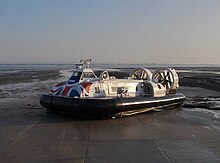
During the 1960s, Saunders-Roe developed several larger designs that could carry passengers, including theSR.N2,which operated across theSolent,in 1962, and later theSR.N6,which operated across the Solent fromSouthseatoRydeon the Isle of Wight for many years. In 1963 the SR.N2 was used in experimental service betweenWeston-super-MareandPenarthunder the aegis of P & A Campbell, the paddle steamer operators.
Operations byHovertravelcommenced on 24 July 1965, using the SR.N6, which carried 38 passengers.[30]Two 98 seatAP1-88hovercraft were introduced on this route in 1983, and in 2007, these were joined by the first 130-seatBHT130craft. The AP1-88 and the BHT130 were notable as they were largely built by Hoverwork using shipbuilding techniques and materials (i.e. welded aluminium structure and diesel engines) rather than the aircraft techniques used to build the earlier craft built by Saunders-Roe-British Hovercraft Corporation. Over 20 million passengers had used the service as of 2004 – the service is still operating (as of 2020[update]) and is by far the longest, continuously-operated hovercraft service.
In 1966, two cross-channel passenger hovercraft services were inaugurated using SR.N6 hovercraft.Hoverlloydran services fromRamsgateHarbour, England, toCalais,France, andTownsend Ferriesalso started a service to Calais from Dover, which was soon superseded by that ofSeaspeed.
As well as Saunders-Roe and Vickers (which combined in 1966 to form the British Hovercraft Corporation (BHC)), other commercial craft were developed during the 1960s in the UK byCushioncraft(part of theBritten-NormanGroup) and Hovermarine based at Woolston (the latter beingsidewall hovercraft,where the sides of the hull projected down into the water to trap the cushion of air with normal hovercraft skirts at thebowandstern). One of these models, the HM-2, was used byRed Funnelbetween Southampton (near theWoolston Floating Bridge) andCowes.[33]

The world's first car-carrying hovercraft was made in 1968, the BHCMountbattenclass(SR.N4) models, each powered by fourBristol Proteusturboshaftengines. These were both used by rival operatorsHoverlloydandSeaspeed(which joined to formHoverspeedin 1981) to operate regular car and passenger carrying services across the English Channel. Hoverlloyd operated fromRamsgate,where a specialhoverporthad been built at Pegwell Bay, to Calais. Seaspeed operated from Dover, England, to Calais andBoulognein France. The first SR.N4 had a capacity of 254 passengers and 30 cars, and a top speed of 83 kn (154 km/h). The channel crossing took around 30 minutes and was run like an airline with flight numbers. The later SR.N4 Mk.III had a capacity of 418 passengers and 60 cars. These were later joined by the French-built SEDAMN500 Naviplanewith a capacity of 385 passengers and 45 cars; only one entered service and was used intermittently for a few years on the cross-channel service until returned toSNCFin 1983. The service ceased on 1 October 2000 after 32 years, due to competition with traditional ferries,catamarans,the disappearance of duty-free shopping within the EU, the advancing age of the SR.N4 hovercraft, and the opening of theChannel Tunnel.[34]
The commercial success of hovercraft suffered from rapid rises in fuel prices during the late 1960s and 1970s, following conflict in the Middle East. Alternative over-water vehicles, such as wave-piercing catamarans (marketed as theSeaCatin the UK until 2005), use less fuel and can perform most of the hovercraft's marine tasks. Although developed elsewhere in the world for both civil and military purposes, except for theSolentRyde-to-Southsea crossing, hovercraft disappeared from the coastline of Britain until a range ofGriffon Hoverworkwere bought by theRoyal National Lifeboat Institution.
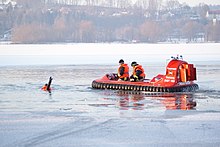
Hovercraftused to ply between theGateway of IndiainMumbaiandCBD BelapurandVashiinNavi Mumbaibetween 1994 and 1999, but the services were subsequently stopped due to the lack of sufficientwater transport infrastructure.[35]
Civilian non-commercial[edit]

In Finland, small hovercraft are widely used in maritime rescue and during therasputitsa( "mud season" ) asarchipelagoliaison vehicles. In England, hovercraft of theBurnham-on-SeaArea Rescue Boat (BARB) are used to rescue people from thick mud inBridgwater Bay.Avon Fire and Rescue Servicebecame the first Local Authority fire service in the UK to operate a hovercraft. It is used to rescue people from thick mud in theWeston-super-Marearea and during times of inland flooding. A Griffon rescue hovercraft has been in use for a number of years with the Airport Fire Service at Dundee Airport in Scotland. It is used in the event of an aircraft ditching in the Tay estuary. Numerous fire departments around the US/Canadian Great Lakes operate hovercraft for water and ice rescues, often of ice fisherman stranded when ice breaks off from shore. The Canadian Coast Guard uses hovercraft to break light ice.[36][37]

In October 2008, The Red Cross commenced a flood-rescue service hovercraft based inInverness,Scotland.[38]Gloucestershire Fire and Rescue Servicereceived two flood-rescue hovercraft donated bySevern Trent Waterfollowing the2007 UK floods.[39]
Since 2006, hovercraft have been used in aid in Madagascar by HoverAid, an international NGO who use the hovercraft to reach the most remote places on the island.[40]
The Scandinavian airlineSASused tocharteran AP1-88 hovercraft for regular passengers betweenCopenhagen Airport,Denmark, and the SAS HovercraftTerminalinMalmö,Sweden.
In 1998, the US Postal Service began using the British builtHoverwork AP1-88to haul mail, freight, and passengers fromBethel, Alaska,to and from eight small villages along theKuskokwim River.Bethel is far removed from the Alaska road system, thus making the hovercraft an attractive alternative to the air based delivery methods used prior to introduction of the hovercraft service. Hovercraft service is suspended for several weeks each year while the river is beginning to freeze to minimize damage to the river ice surface. The hovercraft is able to operate during the freeze-up period; however, this could potentially break the ice and create hazards for villagers using their snowmobiles along the river during the early winter.[citation needed]

In 2006, Kvichak Marine Industries ofSeattle,US built, under licence, a cargo/passenger version of the HoverworkBHT130.Designated 'Suna-X', it is used as a high-speed ferry for up to 47 passengers and 47,500 pounds (21,500 kg) of freight serving the remote Alaskan villages ofKing CoveandCold Bay.
An experimental service was operated in Scotland across theFirth of Forth(betweenKirkcaldyandPortobello, Edinburgh), from 16 to 28 July 2007. Marketed asForthfast,the service used a craft chartered fromHovertraveland achieved an 85%passenger load factor.As of 2009[update],the possibility of establishing a permanent service is still under consideration.[41]
Since the Channel routes abandoned hovercraft, and pending any reintroduction on the Scottish route, the United Kingdom's only public hovercraft service is that operated byHovertravelbetweenSouthsea(Portsmouth) andRydeon theIsle of Wight.[citation needed]
From the 1960s, several commercial lines were operated in Japan, without much success. In Japan the last commercial line had linkedŌita Airportand centralŌitabut was shut down in October 2009.[citation needed]However, the commercial line between Ōita Airport and central Ōita is scheduled to reopen in 2024.[citation needed]
Hovercraft are still manufactured in the UK, near to where they were first conceived and tested, on the Isle of Wight.[citation needed]They can also be chartered for a wide variety of uses including inspections of shallow bed offshore wind farms and VIP or passenger use. A typical vessel would be a Tiger IV or a Griffon. They are light, fast, road transportable and very adaptable with the unique feature of minimising damage to environments.
Military[edit]
China[edit]

The People's Army Navy ofChinaoperates theJingsah II class LCAC.This troop and equipment carrying hovercraft is roughly the Chinese equivalent of the U.S. NavyLCAC.
Finland[edit]
TheFinnish Navydesigned an experimental missile attack hovercraft class,Tuuli class hovercraft,in the late 1990s. The prototype of the class,Tuuli,was commissioned in 2000. It proved an extremely successful design for alittoralfast attack craft, but due to fiscal reasons and doctrinal change in the Navy, the hovercraft was soon withdrawn.
Iran[edit]
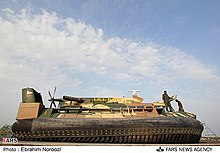
TheIranian Navyoperates multiple British-made[42][43]and some Iranian-produced hovercraft.[44][45]TheTondaror Thunderbolt comes in varieties designed for combat and transportation. Iran has equipped the Tondar with mid-range missiles, machine guns and retrievable reconnaissance drones. Currently they are used for water patrols and combat against drug smugglers.
Russia[edit]

TheSoviet Unionwas the world's largest developer of military hovercraft. Their designs range from the smallCzilim-class hovercraft,comparable to the SR.N6, to the monstrousZubr-classlanding craft,the world's largest hovercraft.[when?]The Soviet Union was also one of the firstnationsto use a hovercraft, theBora,as aguided missilecorvette,though it is more properly classified as asurface effect shipbecause it has rigid, non-inflatable sides. With the fall of the Soviet Union, most Soviet military hovercraft fell into disuse and disrepair. Only recently has the modernRussian Navybegun building new classes of military hovercraft.
United Kingdom[edit]
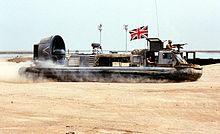
The first application of the hovercraft for military use was by theBritish Armed Forces,using hovercraft built by Saunders-Roe. In 1961, the United Kingdom set up the Interservice Hovercraft Trials Unit (IHTU) based atRNAS Lee-on-Solent (HMS Daedalus),now the site of theHovercraft Museum,nearPortsmouth.[46]This unit carried out trials on the SR.N1 from Mk1 through Mk5 as well as testing theSR.N2,SR.N3,SR.N5andSR.N6craft. The Hovercraft Trials Unit (Far East) was established by the Royal Navy atSingaporein August 1964 with two armed hovercraft; they were deployed later that year toTawauin MalaysianBorneoand operated on waterways there during theIndonesia–Malaysia confrontation.[47]The hovercraft's inventor, SirChristopher Cockerell,claimed late in his life that theFalklands Warcould have been won far more easily had the British military shown more commitment to the hovercraft;[48]although earlier trials had been conducted in the Falkland Islands with an SRN-6, the hovercraft unit had been disbanded by the time of the conflict.[49]Currently, theRoyal Marinesuse theGriffonhoverwork 2400TDhovercraft, the replacement for the Griffon 2000 TDX Class ACV, which was deployed operationally by the marines in the2003 invasion of Iraq.[50]
United States[edit]
During the 1960s,Belllicensed and sold the Saunders-Roe SR.N5 as the Bell SK-5. They were deployed on trial to theVietnam Warby theUnited States NavyasPACVpatrol craftin theMekong Deltawhere theirmobilityandspeedwas unique. This was used in both the UK SR.N5 curveddeckconfiguration and later with modified flat deck,gun turretandgrenade launcherdesignated the 9255 PACV. The United States Army also experimented with the use of SR.N5 hovercraft in Vietnam. Three hovercraft with the flat deck configuration were deployed toĐồng Tâmin the Mekong Delta region and later to Ben Luc. They saw action primarily in thePlain of Reeds.One was destroyed in early 1970 and another in August of that same year, after which the unit was disbanded. The only remaining U.S. Army SR.N5 hovercraft is currently on display in theArmy Transport MuseuminVirginia.
Experience led to the proposed Bell SK-10, which was the basis for theLCAC-classair-cushioned landing craftnow deployed by the U.S. andJapanese Navy.Developed and tested in the mid-1970s, theLACV-30was used by the US Army to transport military cargo in logistics-over-the-shore operations from the early 1980s until the mid-1990s.[51]
-
A U.S. patrol air cushion vehicle (PACV) in Cau Hai Bay near Hue South Vietnam 1968
-
AU.S. NavyLanding Craft Air Cushion, an example of a military hovercraft
Recreational/sport[edit]
Small commercially manufactured, kit or plan-built hovercraft are increasingly being used for recreational purposes, such as inland racing and cruising on inland lakes and rivers, marshy areas, estuaries and inshore coastal waters.[52]
The Hovercraft Cruising Club[53]supports the use of hovercraft for cruising in coastal and inland waterways, lakes and lochs.
TheHovercraft Club of Great Britain,founded in 1966, regularly organizes inland and coastal hovercraft race events at various venues across the United Kingdom.[54]Similar events are also held in Europe and the US.[55][56]
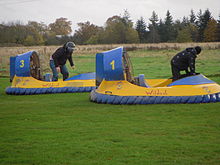
In August 2010, the Hovercraft Club of Great Britain hosted the World Hovercraft Championships at Towcester Racecourse,[57]followed by the 2016 World Hovercraft Championships at the West Midlands Water Ski Centre in Tamworth.
The World Hovercraft Championships are run under the auspices of the World Hovercraft Federation.[58]So far the World Hovercraft Championships had been hosted by France: 1993 in Verneuil, 1997 in Lucon, 2006 at the Lac de Tolerme; Germany: 1987 in Bad Karlshafen, 2004 in Berlin, 2012 and 2018 in Saalburg; Portugal: 1995 in Peso de la Regua; Sweden: 2008 and 2022 at Flottbro Ski Centre in Huddinge; UK 1991 and 2000 at Weston Parc; US: 1989 in Troy (Ohio), 2002 in Terre Haute. The 2020 World Hovercraft Championships had to be postponed to 2022 due to restriction caused by the Covid-19 outbreak.
Apart from the craft designed as "racing hovercraft", which are often only suitable for racing, there is another form of small personal hovercraft for leisure use, often referred to as cruising hovercraft, capable of carrying up to four people. Just like their full size counterparts, the ability of these small personal hovercraft to safely cross all types of terrain, (e.g. water, sandbanks, swamps, ice, etc.) and reach places often inaccessible by any other type of craft, makes them suitable for a number of roles, such as survey work and patrol and rescue duties in addition to personal leisure use. Increasingly, these craft are being used as yacht tenders, enabling yacht owners and guests to travel from a waiting yacht to, for example, a secluded beach. In this role, small hovercraft can offer a more entertaining alternative to the usual small boat and can be a rival for the jet-ski. The excitement of a personal hovercraft can now be enjoyed at "experience days", which are popular with families, friends and those in business, who often see them as team building exercises. This level of interest has naturally led to a hovercraft rental sector and numerous manufacturers of small, ready built designs of personal hovercraft to serve the need.[59]
Other uses[edit]
Hoverbarge[edit]
A real benefit of air cushion vehicles in moving heavy loads over difficult terrain, such as swamps, was overlooked by the excitement of the British Government funding to develop high-speed hovercraft. It was not until the early 1970s that the technology was used for moving a modular marine barge with a dragline on board for use over soft reclaimed land.
Mackace (Mackley Air Cushion Equipment), now known as Hovertrans, produced a number of successful Hoverbarges, such as the 250 ton payload "Sea Pearl", which operated in Abu Dhabi, and the twin 160 ton payload "Yukon Princesses", which ferried trucks across the Yukon River to aid the pipeline build. Hoverbarges are still in operation today. In 2006, Hovertrans (formed by the original managers of Mackace) launched a 330-ton payload drilling barge in the swamps of Suriname.[60]
The Hoverbarge technology is somewhat different from high-speed hovercraft, which has traditionally been constructed using aircraft technology. The initial concept of the air cushion barge has always been to provide a low-tech amphibious solution for accessing construction sites using typical equipment found in this area, such as diesel engines, ventilating fans, winches and marine equipment. The load to move a 200 ton payload ACV barge at 5 kn (9.3 km/h) would only be 5 tons. The skirt and air distribution design on high-speed craft again is more complex, as they have to cope with the air cushion being washed out by a wave and wave impact. The slow speed and large mono chamber of the hover barge actually helps reduce the effect of wave action, giving a very smooth ride.
The low pull force enabled aBoeing 107helicopterto pull a hoverbarge across snow, ice and water in 1982.[61][62]
Hovertrains[edit]
Several attempts have been made to adopt air cushion technology for use in fixed track systems, in order to use the lower frictional forces for delivering high speeds. The most advanced example of this was theAérotrain,an experimental high speedhovertrainbuilt and operated inFrancebetween 1965 and 1977. The project was abandoned in 1977 due to lack of funding, the death of its lead engineer and the adoption of theTGVby the French government as its high-speed ground transport solution.
A test track for a tracked hovercraft system was built atEarithnearCambridge,England.It ran southwest fromSutton Gault,sandwiched between theOld Bedford Riverand the smaller Counter Drain to the west. Careful examination of the site will still reveal traces of the concrete piers used to support the structure. The actual vehicle, RTV31, is preserved atRailworldinPeterborough[63]and can be seen from trains, just south west ofPeterborough railway station.The vehicle achieved 104 mph (167 km/h) on 7 February 1973[64]but the project was cancelled a week later. The project was managed by Tracked Hovercraft Ltd., with Denys Bliss as Director in the early 1970s, then axed by the Aerospace Minister,Michael Heseltine.Records of this project are available from the correspondence and papers ofSir Harry Legge-Bourke, MPat Leeds University Library.[65]Heseltine was accused byAirey Neaveand others of misleading the House of Commons when he stated that the government was still considering giving financial support to the Hovertrain, when the decision to pull the plug had already been taken by the Cabinet.
After the Cambridge project was abandoned due to financial constraints, parts of the project were picked up by the engineering firmAlfred McAlpine,and abandoned in the mid-1980s. The Tracked Hovercraft project andProfessor Laithwaite'sMaglev trainsystem were contemporaneous, and there was intense competition between the two prospective British systems for funding and credibility.
At the other end of the speed spectrum, theU-Bahn Serfaushas been in continuous operation since 1985. This is an unusual underground air cushionfunicularrapid transitsystem, situated in the Austrianski resortofSerfaus.Only 1,280 m (4,200 ft) long, the line reaches a maximum speed of 25 mph (40 km/h). Asimilar systemalso exists inNarita International Airportnear Tokyo, Japan.
In the late 1960s and early 1970s, the U.S. Department of Transport'sUrban Mass Transit Administration(UMTA) funded several hovertrain projects, which were known as Tracked Air Cushion Vehicles or TACVs. They were also known as Aerotrains since one of the builders had a licence from Bertin's Aerotrain company. Three separate projects were funded. Research and development was carried out byRohr, Inc.,Garrett AiResearchandGrumman.UMTA built an extensive test site inPueblo, Colorado,with different types of tracks for the different technologies used by the prototype contractors. They managed to build prototypes and do a few test runs before the funding was cut.
Heavy haulage[edit]
From the 1960s to 1980s, heavy haulers in theUKused an air-cushion system for theirhydraulic modular trailersto carryoverweight loadsover bridges which were not able to bear the weight of the load and the trailer.[66]TheCentral Electricity Generating Boardhad to movetransformersfrom one place to another which weighed from 150 tons to 300 tons for which they did not have appropriate equipment; so they hired heavy haulers like Wynns andPickfordswho had specialized equipment like hydraulic modular trailers manufactured byNicolasandCometto,andballast tractorsfromScammellwhich were strong and powerful enough to carry the load. This made the transportation efficient by avoiding bridge reinforcement, in some cases costing€30,000.
The transformers were loaded into the girder frame of the hydraulic modular trailer with axle lines in front and behind of the transformer, which made it possible to keep the transformer as low as possible to the ground to negotiate obstacles on the route. Air cushions were mounted under the girder frame's surface and were operated by acompressorvehicle which was a customizedCommer16-ton maxiload provided by CEGB. The vehicle was loaded with 4 air compressors powered by aRolls-Royceengine producing 235 bhp. While negotiating a bridge the air cushions were inflated and that reduced the stress tremendously on the bridge. Without this technology the government would have had to rebuild the bridges which was not feasible just to carry a small number of loads.[67]
Non-transportation[edit]
TheHoover Constellationwas a spherical canister-typevacuum cleanernotable for its lack of wheels. Floating on a cushion of air, it was adomestichovercraft. They were not especially good as vacuum cleaners as the air escaping from under the cushion blew uncollected dust in all directions, nor as hovercraft as their lack of a skirt meant that they only hovered effectively over a smooth surface. Despite this, original Constellations are sought-aftercollectiblestoday.
TheFlymois an air-cushionlawn mowerthat uses a fan on the cutter blade to provide lift. This allows it to be moved in any direction, and provides double-duty as a mulcher.
TheMarylebone Cricket Clubowns a "hover cover"that it uses regularly to cover the pitch atLord's Cricket Ground.This device is easy and quick to move, and has no pressure points, making damage to the pitch less likely.
Apower trowelis a hovercraft device used for skimming concrete.
Features[edit]
Advantages[edit]
- Terrain-independence - crossing beachfronts and slopes up to 40 degrees
- All-season capability - frozen or flowing rivers no object
- Speed
- Flexibility, due to low surface friction
Disadvantages[edit]
- Engine noise emissions
- Initial costs
- Proneness to contrary winds
- Skirtwear and tear
Preservation[edit]
TheHovercraft MuseumatLee-on-the-Solent,Hampshire, England, houses the world's largest collection of hovercraft designs, including some of the earliest and largest. Much of the collection is housed within the retiredSR.N4hovercraftPrincess Anne.She is the last of her kind in the world. There are many hovercraft in the museum but all are non-operational.
As of 2023[update],Hovercraft continue in use between Ryde on the Isle of Wight and Southsea on the English mainland. The service, operated byHovertravel,schedules up to three crossings each hour, and provides the fastest way of getting on or off the island. Large passenger-hovercraft are still manufactured on the Isle of Wight.
Records[edit]
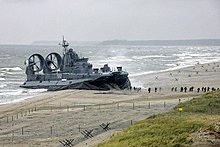
- World's largest civil hovercraft[68]– The BHCSR.N4Mk.III, at 56.4 m (185 ft) length and 310 metric tons (305 long tons) weight, can accommodate 418 passengers and 60 cars.
- World's largest military hovercraft – The RussianZubr class LCACat 57.6 metres (188 feet) length and a maximum displacement of 535 tons. This hovercraft can transport threeT-80main battle tanks(MBT), 140 fully equipped troops, or up to 130 tons of cargo. Four have been purchased by theGreek Navy.
- English Channelcrossing – 22 minutes byPrincess AnneMountbatten class hovercraftSR.N4 Mk.III on 14 September 1995
- World hovercraft speed record[69]– 137.4 km/h (85.38 mph or 74.19 knots). Bob Windt (USA) at World Hovercraft Championships, Rio Douro River, Peso de Regua, Portugal on 18 September 1995.
- Hovercraft land speed record[70]– 56.25 mph (90.53 km/h or 48.88 knots). John Alford (USA) at Bonneville Salt Flats, Utah, USA on 21 September 1998.
- Longest continuous use – The original prototypeSR.N6 Mk.I(009) was in service for over 20 years, and logged 22,000 hours of use. It is currently on display at theHovercraft MuseuminLee-on-the-Solent,Hampshire,England.
See also[edit]
References[edit]
Notes[edit]
- ^Hovercraft Definition and Meaning,collinsdictionary,retrieved2 July2019
- ^Wragg, David W. (1973).A Dictionary of Aviation(first ed.). Osprey. p. 18.ISBN9780850451634.
- ^Parkinson, Justin (9 November 2015)."What happened to passenger hovercraft?".UK: BBC.Retrieved30 January2021.
- ^Noble, Will (13 August 2021)."The hovercraft that kept on going".CNN Travel.
- ^Sekiya, Yohei; Shimbun, Yomiuri (3 September 2023)."Hovercraft to Return to Oita, Ferrying Passengers to Airport".Yomiuri Shimbun.Japan.Retrieved4 July2024.
- ^"Griffon Hoverwork wins £25m Japan export deal"(Press release). UK: Griffon Hoverwork.Retrieved4 July2024.
- ^"House of Commons Debates: Hovercraft Bill",Parliamentary Debates (Hansard),vol. 764, cc1479-522, 16 May 1968,archivedfrom the original on 27 November 2012,retrieved26 May2012
- ^"BBC ON THIS DAY - 11 - 1959: Hovercraft marks new era in transport".BBC News.11 June 1959.Archivedfrom the original on 6 January 2008.Retrieved10 July2007.
- ^"Technic - Austro-Hungarian Hovercraft - The Development".Homepages.fh-giessen.de. 26 March 1915. Archived fromthe originalon 9 October 2007.Retrieved26 May2012.
- ^Tsiolkovskii, Konstantin,Friction and resistance of air(in Russian), personal archive published by theRussian Academy of Sciences(in author's own handwriting), pp.55and56
- ^""Russia and the Ground-effect Vehicle".Flight International.5 April 1962.Archivedfrom the original on 5 October 2015.Retrieved5 October2015.
- ^ab"Cars that Fly".Modern Mechanix.October 1959. pp. 92–95. Archived fromthe originalon 29 January 2016.
- ^"TamPub"(PDF).uta.fi.Archived(PDF)from the original on 26 March 2012.Retrieved22 January2010.
- ^"Судно на воздушной подушке"[Hovercraft] (in Russian).Great Soviet Encyclopedia.Archivedfrom the original on 14 August 2011.Retrieved6 May2013.
- ^Первый боевой корабль на воздушной подушке, советский торпедный катер Л-5[The first air-cushion warship, the Soviet torpedo boat L-5]. 1940.Archivedfrom the original on 10 May 2019.Retrieved17 November2017– via YouTube.
- ^Inventor of the week: Christopher Cockerell,MIT, August 2007, archived fromthe originalon 13 June 2012,retrieved24 April2012
- ^Brophy, Jim (4 September 2021)."1959 Curtiss-Wright Air Car 2500 – Like Riding on a Cloud…".Curbside Classic.Retrieved4 May2022.
- ^Wojdyla, Ben (2 February 2015)."Luke Skywalker, your landspeeder is ready".Road & Track.Retrieved4 May2022.
- ^"1959 Curtiss-Wright Model 2500 Air-Car".ThrottleXtreme.18 October 2017.Retrieved4 May2022.
- ^"This Unbelievable 1959 Curtiss-Wright Model 2500 Air-Car".Design You Trust.Retrieved4 May2022.
- ^"April Artifact of the Month: Curtiss-Wright Model 2500 Air Car".U.S. Army Transportation Museum.23 March 2021.Retrieved4 May2022.
- ^Ford, Jason (18 June 2019)."June 1960: Floating a new idea".The Engineer.Archived fromthe originalon 18 June 2019.Retrieved11 May2020– via theengineer.co.uk.
- ^"Locomotion"(PDF).The Engineer.3 June 1960. p. 930. Archived fromthe original(PDF)on 3 May 2022.Retrieved4 May2022– via theengineer.co.uk.
- ^"Air apparent",Maritime Defence Management Journal, Issue 47
- ^Raymond Wheeler, "From River to Sea", Cross Publishing, 1993
- ^Bill Gunston, "Hydrofoils and Hovercraft: new vehicles for sea and land", Doubleday, 1969, p.93
- ^as part of consolidation of British helicopter activities by several aero companies into one
- ^"Hovercraft: New Generations Ahead".Flight International:528. 5 October 1961.Archivedfrom the original on 22 June 2012.Retrieved13 January2010.
- ^"Aérotrain et Naviplanes - L'histoire de la SEDAM et des Naviplanes".Aérotrain et Naviplanes.Archivedfrom the original on 27 September 2011.Retrieved28 July2006.
- ^abcLefeaux, John (2001).Whatever Happened to the Hovercraft?.Pentland Books.ISBN1-85821-850-0.
- ^"Hoylake-Rhyl Hovercraft Service".Archivedfrom the original on 1 February 2014.Retrieved8 February2013.
- ^"Media | Hovertravel Isle of Wight Ferry".Retrieved30 April2021.
- ^"Hovercraft of Hovermarine Transport Ltd".18 December 1974.Archivedfrom the original on 29 May 2012.Retrieved26 May2012.
- ^Young, Robin (2 October 2000). "Fans mourn last hovercraft crossing".The Times.UK. p. 6.
- ^"Navi Mumbai mulls hovercraft services".Sify.Navi Mumbai. 3 November 2011. Archived fromthe originalon 24 September 2015.Retrieved3 January2015.
- ^"CCGS Mamilossa".Archived fromthe originalon 8 December 2015.Retrieved4 December2015.
- ^"CCGS Sipu Muin".Archived fromthe originalon 8 December 2015.Retrieved4 December2015.
- ^"SVCO".[permanent dead link]
- ^"County lends Cumbria hovercraft".BBC News.20 November 2009.Retrieved4 May2010.
- ^ "hoveraid.org - Home".hoveraid.org.Archivedfrom the original on 13 February 2014.Retrieved10 February2014.
- ^"Forthfast".Stagecoach Bus.Retrieved12 September2009.
- ^"LCAC / PGAC Wellington BH.7 (Iran) class".harpoondatabases. Archived fromthe originalon 22 February 2014.Retrieved10 February2014.
- ^Pike, John."Iranian Warships".globalsecurity.org.Archivedfrom the original on 6 April 2014.Retrieved10 February2014.
- ^"Iran unveils home-made missile launching hovercraft - NZweek".nzweek.Archivedfrom the original on 23 February 2014.Retrieved10 February2014.
- ^"Media/images/1388/03/06/100907865558".jamejamonline.ir.Archivedfrom the original on 6 March 2014.Retrieved10 February2014.
- ^Yun, Liang; Bliault, Alan (2012).High Performance Marine Vessels.New York: Springer. p. 323.ISBN978-1461408680.
- ^Roberts, John (2009).Safeguarding the Nation: The Story of the Modern Royal Navy.Seaforth Publishing. p. 69.ISBN978-1848320437.
- ^Margolis, Jonathan (10 December 1995). "Hover bother on the horizon".The Sunday Times.
- ^Hollebone, Ashley (2012).The Hovercraft: A History.The History Press. p. 107.ISBN978-0752464794.
- ^"Griffon Hoverwork secure Ministry of Defence contract".blandgroup.Bland Group UK Holdings Ltd. 13 November 2019.Retrieved11 July2020.
- ^Pike, John."Lighter Air Cushioned Vehicle 30-ton (LACV 30)".globalsecurity.org.Archivedfrom the original on 21 September 2016.Retrieved22 May2016.
- ^ "Welcome to the Hovercruiser Web site".hovercruiser.org.uk. 2008.Archivedfrom the original on 3 February 2010.Retrieved24 October2009.
- ^"Hovercraft Cruising Club UK!".Archivedfrom the original on 27 December 2018.Retrieved17 May2019.
- ^"Hovercraft Club of Great Britain".Archivedfrom the original on 25 September 2009.Retrieved24 October2009.
- ^"European Hovercraft Federation".2011.Archivedfrom the original on 4 July 2011.Retrieved23 June2011.
- ^"Hoverclub of America".2011.Archivedfrom the original on 28 June 2011.Retrieved23 June2011.
- ^"World Hovercraft Championships".2010. Archived fromthe originalon 3 May 2010.Retrieved16 May2010.
- ^ "World Hovercraft Federation".2011.Archivedfrom the original on 17 February 2015.Retrieved17 May2019.
- ^ "RC Hovercraft".hovercrafthq.Archivedfrom the original on 17 December 2014.Retrieved10 December2014.
- ^"Hover barge History".Hovertrans.UK. 25 August 2010. Archived from the original on 25 August 2010.Retrieved26 March2023.
{{cite web}}:CS1 maint: unfit URL (link) - ^"Happy birthday to Columbia Helicopters! Oregon-based company celebrates its 50th anniversary".Vertical.18 April 2007.Retrieved24 August2012.
- ^"The hover barge".Columbia Helicopters.Archived fromthe originalon 13 February 2016.Retrieved24 August2012.
- ^"Hover Trains".Railworld. Archived fromthe originalon 10 September 2007.Retrieved12 September2009.
- ^"*** MISSING TITLE *** MISSING TITLE ***",The Railway Magazine,p. 235, May 1973
- ^ "Correspondence and papers of Sir Harry Legge-Bourke, MP"(PDF).University of Leeds. 2 June 2004.Archived(PDF)from the original on 27 March 2009.Retrieved14 October2009.
- ^"Totally ace!".Heavy Torque.No. 18. April 2019.Retrieved27 May2023.
- ^Cater, Ron (5 June 1970)."CEGB's problems are seldom little ones".Commercial Motor.pp. 80–82.Retrieved27 May2023.
- ^"Largest Hovercraft".Guinness World Records. Archived fromthe originalon 25 May 2006.Retrieved18 July2006.
- ^"Guinness World Records - Fastest Hovercraft".Archivedfrom the original on 3 November 2014.Retrieved2 November2014.
- ^"Fastest speed on land for a hovercraft".Archivedfrom the original on 3 November 2014.Retrieved2 November2014.
Bibliography[edit]
- "The Rohr Aerotrain Tracked Air-Cushioned Vehicle (TACV)".SHONNER Studios. Archived fromthe originalon 7 April 2014.Retrieved24 October2009.Web page on tracked air cushion vehicle research in the U.S.
- Volpe, John (December 1969). "Coming: Streamliners Without Wheels".Popular Science:51.Article on tracked air cushion vehicle research in the U.S.
External links[edit]
- HovercraftatCurlie
- "The Future of Hovercraft"
- Hovercraft Museumat Lee-on-Solent, Gosport, UK
- 1965 filmof theDennyD2 hoverbus from theScottish Screen Archive,National Library of Scotland
- Royal Marines Super Hovercraft
- Simple Potted History of the Hovercraft
- Hovercraft Club of Great Britain
- Air cushion technology for heavy haulage in 1967.


